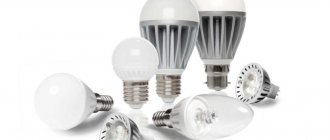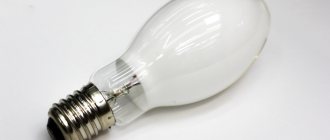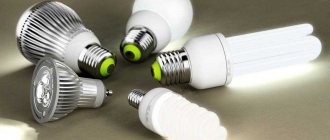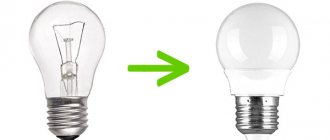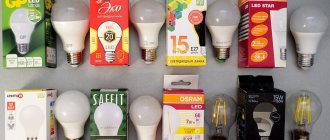Today, many already know that, unlike simple incandescent or halogen lamps, not all LED lamps are dimmable.
But if you still need to control the brightness of LED lighting, how do you usually choose such lamps and dimmer luminaires?
First of all, we look at the packaging. It must have a special dimmable icon on it.
Such lamps will cost a little more than conventional LED lamps. In conventional ones, the driver compensates for voltage fluctuations to the optimal operating current.
Therefore, if you connect a simple LED lamp to a dimmer, it will still shine with constant brightness, no matter how you twist the knob. In extreme cases, the light will start blinking.
No matter what sophisticated and modern dimmer you buy, you will not be able to correct the situation. Although there are rare exceptions.
When is a regular LED lamp dimmed?
Sometimes a regular LED lamp can still show “signs” of dimming, even if it is not designed for this. This applies primarily to cheap Chinese copies.
They are equipped with the most primitive driver, without any protection against current overloads and voltage surges. It is this design flaw that allows them to dim randomly.
Moreover, within very narrow and limited limits. For other LED lamps, this is basically impossible. Therefore, it is better to always look for models with the Dimmable icon in stores.
By the way, the opposite rule also applies here - if you are not going to adjust the brightness of your lamp, then there is no point in overpaying and purchasing dimmable copies. Keep this in mind.
There are lamps that seem to be dimmable, but poorly. At the same time, some craftsmen try to cheat and include one ordinary incandescent lamp in a chain of parallel-connected, poorly regulated LED specimens.
This circuit greatly affects the overall resistance, especially when the temperature of the tungsten filament changes. This feature allows, in certain cases, to expand the dimming range of LED light bulbs.
However, the service life of such a circuit and its individual elements will be far from that declared by the manufacturers. Most lamps may simply fail soon.
Filament lamps and dimmer
In addition to the usual SMD-based LED lamps, so-called filament and similar lamps have recently become popular. They are very similar in appearance to simple incandescent light bulbs.
By the way, this is how many people are bribed and misled. Most people think that they are purchasing a full-fledged replacement for the “Ilyich light bulb,” only a more economical and durable option.
However, it is still the same LED bulb and is subject to the same laws and dimming rules as its cousins.
1 of 2
At the same time, if you nevertheless selected a dimmer for such a light source, and are going to replace all your incandescent lamps with it, do not forget about the significant differences and not entirely pleasant effects.
The fact that most LED lamps begin to flicker strongly when the brightness decreases and their pulsation coefficient increases sharply is no longer a secret to anyone.
But at the same time, many are still surprised that when they connect a modern lamp to a dimmer, they do not get the same comfort and warmth effect as from conventional incandescent light bulbs.
Changing color temperature
At maximum power, the light bulb will shine as expected, according to its characteristics. But when you dim and reduce the brightness, you will get a completely different light than you expected.
The fact is that the color temperature of an incandescent lamp changes significantly when dimming. And with your vision, willingly or unwillingly, you notice it.
It does not remain constant at all around 2700K, but goes to the limit of 1500K. And only at maximum heat will the same 2700K be produced.
Moreover, if an increased voltage of more than 220V (240-250V) is supplied to the light bulb, then it will not produce this same 2700K at maximum.
But LEDs cannot repeat this “trick”. Whether this is a disadvantage or an advantage is difficult to say. But the fact remains a fact.
When the brightness is reduced, LED lamps shine differently than we are used to. And you will feel it with your vision. There won’t be that same “lampiness” and comfort.
It turns out that even when the dimmer is turned to the very minimum, the light emitted in them is the same temperature as stated on the packaging or case.
If it is indicated that the color temperature of a given specimen is 2700K, then it will remain so. It doesn't matter what dimmer you connect to it.
Visually the difference is very strong. The light turns out whiter. Here's a good example.
One chandelier simultaneously contains simple incandescent light bulbs (on the right) and one LED light bulb (on the left). All have the same temperature and equivalent power. This is how the chandelier glows at maximum.
As you can see, there is practically no difference. And so, this same chandelier glows at the lowest dimmer setting. The result, as they say, is obvious.
This will be especially noticeable if you use a dimmer to turn a simple lamp into a night light. In this case, it is better not to save money and choose real night lamps that provide complete, dim and comfortable light in the bedroom.
In order to somehow influence the situation, LED lamps with a temperature of 2000K have recently begun to be mass-produced. Some manufacturers even give the glass bulb an orange tint.
All this is precisely connected with an attempt to achieve maximum similarity with the good old incandescent light bulbs that we love so much.
Even most vintage LED lamps, which simulate an incandescent filament inside, also come with this temperature.
The most popular manufacturers
When buying LED lamps, pay attention to the manufacturer. This allows you to purchase high-quality products with a long service life. There are several well-known brands on the domestic market offering high-quality lamps.
Osram
This German company is known throughout the world as a manufacturer of high-quality lamps, luminaires and other lighting equipment. It produces LED lamps in a wide range, with sockets of different types and sizes.
Lamps with E14 and E27 sockets are produced in the form of balls and candles; they are used in chandeliers, floor lamps, and lamps.
Pros:
- high color rendering coefficient - above 80;
- large selection of lamps;
- excellent performance characteristics, including inexpensive models;
- efficiency.
The disadvantages of Osram products include:
- high cost;
- possibility of marriage.
Philips
Dutch world famous company producing lighting equipment. The brand uses innovation and produces products with a long service life - up to 40 thousand hours.
Pros:
- maintaining brightness with a long service life;
- high energy efficiency;
- safe for vision due to specially set temperature parameters and lack of flicker;
- wide selection of lamps;
- There are models in which the color temperature is adjustable.
Minuses:
- high price;
- small dispersion angle for inexpensive models.
Gauss
Domestic Gauss lamps are distinguished by a wide input voltage range (185-265 V), which expands the possibilities of their use in areas with unstable power supplies and low-quality electricity supplies. Lamps with predominantly rich, bright white light.
Pros:
- high color rendering index – reaches 90;
- long service life - up to 50 thousand hours (if translated into everyday use, the lamps last about 35 years);
- warranty periods – 3-7 years;
- beautiful design, suitable for modern interiors in high-tech style and others;
- There are many models with switchable lighting temperature.
Gauss presents a series of lamps that implement the principle of step dimming. They do not need a dimmer - it is built into the lamp.
Minuses:
- are expensive;
- rarely sold in stores (must be ordered online);
- not compatible with many switches and dimmers - you have to check for compatibility before purchasing.
Uniel
Another domestic manufacturer whose Crystal and Palazzo series are especially popular. The lamps from this company are universal and work with almost all AC dimmers. They have a matte bulb and a standard base, like conventional incandescent lamps. They operate in the range of 175-250 V.
Uniel lamps are sold in all major stores. Previously, they were produced in China, and recently they opened a factory in Russia, which produces the most popular models - pear-shaped lamps with an E27 base. Service life – 30 thousand hours. All products have a three-year warranty.
Pros:
- high color rendering – up to 80;
- wide range of models;
- moderate cost;
- do not reduce brightness when the voltage drops to 133 V.
Minus - they do not work with switches equipped with indicators.
Dimmable lamps allow you not only to adjust the lighting to your needs, but also save energy. The main problem is the incompatibility of devices. To avoid this, carefully study the technical parameters of lamps and dimmers before purchasing.
Minimum brightness level
Another unpleasant point is that with most copies you will never achieve a uniform decrease in brightness, down to zero values.
LED lamps cannot provide the minimum illumination of a room that can be achieved with a barely luminous tungsten filament. That is, with the dimmer turned to its maximum (downwards), a fairly visible flow of light will still be observed.
If you want to reduce it even more, you won’t succeed. Then the light will simply turn off.
In addition, do not forget that different dimmers and light bulbs each have their own minimum level.
It seems that you checked the lamp in the store and liked everything. We brought it home, turned it on through our home brightness control, and the picture was completely different.
Installation Features
The regulator is installed in the same way as the rotary switch, using an identical mounting box in the process. If you need to install a regulator for a specific chandelier or lamp in a room, you can remove the old retro switch and install a dimmer in its place. The last option is the simplest - you do not need to lay any additional wiring to the installation site.
If a dimmer is inserted instead of a retro switch, a phase break is carried out during installation, a wire from an electric meter is connected to the input terminal, and a wire from an LED or incandescent lamp is connected to the output terminal. It is important to carefully monitor the location of the “Input” and “Output” terminals to avoid errors in the process. If you do not have experience connecting electrical appliances, it is advisable to involve a specialist in the process to prevent electric shock.
A correctly selected dimmer will allow you to achieve the optimal level of lighting in the room under various operating conditions of lighting fixtures. In order to avoid breakdowns during operation or emergency situations as a result of network overload, it is advisable to consult with store employees before purchasing.
Dimmer incompatibility
There is also incompatibility of certain types of lamps with certain types of dimmers.
This may be due to the difference in dimming principles. The sinusoid phase in one device is cut off at the leading edge of the Leading edge (R, RL), and in the other at the rear Trailing edge (RC, RCL). Accordingly, in one case the lamp will work normally, but in the other it will not.
Familiarize yourself with the characteristics and check all the inscriptions while still in the store.
Another difference that applies specifically to filament lamps is that they light up a little later. And not only conventional light bulbs, but even later than their other LED counterparts.
You turn the regulator all the way down, but they don’t light up. And only when a certain value is reached, light begins to appear.
Their actual dimming interval is slightly shorter than other types. Therefore, if you are already planning to buy filament lamps, then look for special brightness controls for them.
With almost any dimmer you can catch the position when the light bulbs begin to blink. This occurs due to their unstable operation in the lower and upper control limits.
Lamps from some manufacturers even begin to crackle at the extreme adjustment points. All these problems can be solved with customizable dimmers. In them you can throw out a certain range and configure the microcontroller for the desired operating mode.
Kinds
All dimmers available for purchase for LED and other lighting can be schematically divided into several types:
- Mechanical;
- Electronic contact;
- Electronic contactless.
In the first case, you can dim the lamp by simply turning the mechanical knob in the desired direction. There are also combined dimmers, in which the user has several control methods available at once.
A suitable regulator option for vintage wiring is a dimmer with a rotary mechanism. In some cases, the device is additionally equipped with a control panel and allows you to change settings not only by turning the knob, but also remotely. The principle of operation is simple - just rotate left and right to select the appropriate level of lighting intensity at the moment. If you use a remote control for adjustment, make sure that its beam is directed directly at the regulator body, and the distance between the devices does not exceed 5 meters, otherwise there will be no operation.
Do dimmers save energy?
Another myth is that you save energy when using dimmers. This primarily applies to incandescent lamps.
Most users still believe that if you leave regular incandescent light bulbs in the lamp and turn the dimmer down to 50%, then you will pay 2 times less for the light. This is not entirely true.
To reduce the brightness of an incandescent lamp by half, you need to reduce the voltage by about 80%. In this case, the current strength will decrease slightly due to the nonlinear resistance of the filament.
The actual power consumption of the lamp in this case will be 75-80% of the original. You will receive 2 times less light, and save only a measly 20%.
Therefore, the only real savings are achieved not by dimming, but by replacing simple lamps with LED ones.
Compatibility is always an issue
A consumer interested in using brightness control equipment should know that he will not only have to buy the necessary system components, but also match them together. Often there is a problem of inconsistency between the dimmer and the purchased LED lamp.
This happens due to the fact that there are a large number of electronic circuits for power drivers for lighting devices and control devices on the market.
Products of any domestic, European or Chinese manufacturer have the right to have a voltage threshold unique to them for inclusion. Also, incompatibility can lead to the fact that the range of adjustments is narrowed, and significantly.
For example, there are LED lighting devices that can turn on and operate even at 5% of the rated power. An incorrectly selected dimmer will only be able to control them within 40-100%. This will significantly reduce the functionality of the process.
The dimmer control panel can provide a radio or infrared signal. The first option is more functional, the second is cheaper, which is why it is the most popular
This feature will lead to the fact that the consumer will not save enough energy or will not be able to provide himself with the expected level of comfort. This is also a significant drawback. Other signs of malfunction may also appear.
The most common are the following:
- The power driver of the existing LED lamp makes loud noises that are unpleasant to the user during operation or cannot start the lighting device.
- The maximum voltage at the output of the dimmer does not reach the required 220 Volts, which makes it impossible to use the light bulb at full power.
- Short-term bright flashes when the lighting device is turned on, the duration of which usually does not exceed 1 second.
- Various interruptions in the functioning of the regulator itself, which will not allow you to effectively control LED lamps.
All of the above points indicate that the selection of equipment should be done carefully and competently.
Longer service life
The positive aspect and advantage of constantly operating LEDs in low brightness mode is an increase in their service life.
For example, if you initially take a light bulb twice as powerful as you needed and turn it with a dimmer to the required brightness, such a lamp will 100% last not only the period stated by the factory, but also much longer.
But with halogen lamps the situation may be the opposite. In addition, dimming leads to a reduction in heat generation.
Based on the above, experts always recommend buying dimmers and lamps for them in the same store, with a visual check of the compatibility of their functions. In this case, you will 100% not encounter any surprises or troubles.
